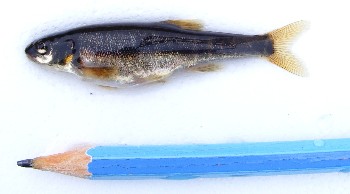Minnow found in the Little Gruinard River system for first time
Posted: Friday 28 August, 2009 @ 11:18:30

The Little Gruinard River is a Special Area of Conservation (SAC) for the Atlantic Salmon. Until yesterday (27th August 2009) only native fish species were know to be present within the river system: European Eel (Anguilla anguilla), Atlantic Salmon (Salmo salar), Brown Trout (Salmo trutta), and Arctic Charr (Salvelinus alpinus) [go to downloads page for charr fry picture]. The Three-spined Stickleback (Gasterosteus aculeatus) is also likely to be present in the lower part of the system.
Yesterday the WRFT electro-fishing team surveyed five sites in streams entering the Fionn Loch at the top of the Little Gruinard. Juvenile salmon and trout were present at all sites. In addition, a Common Minnow (Phoxinus phoxinus) was found in a pool just above the mouth of the Beannach River system, the first record for the Little Gruinard catchment.
The Common Minnow is regarded as a non-native species in Wester Ross. It has been present within the neighbouring River Ewe - Loch Maree system from the 1990s, and was recorded for the first time in the Kanaird, Dundonnell, Gruinard, and Shieldaig (by Loch Torridon) systems since the year 2000.
Maitland (2007) suggests that minnows are able to arrive in new streams by their own efforts, or even birds feet as their eggs are sticky. Perhaps more likely, they may have been introduced as discarded livebait by anglers fishing illegally.
Minnows are considered to be of value as food for other wildlife, including Black-throated diver and Otter. The Fionn Loch is part of a Special Protected Area (SPA) for breeding Black-throated diver. However, minnows are known to competitively displace juvenile trout from some habitats. If juvenile salmonid populations are depressed as a result of minnows, there may be little benefit for breeding divers for which the abundance of larger salmonids (10-15cm) may be of greater importance (Jackson, 2006).
Many questions remain poorly understood. How will minnows affect juvenile salmon production? Do juvenile trout and salmon eat minnows? The WRFT biologist is unaware of any records of minnows being found in the stomach contents of trout or salmon. Please get in touch with the WRFT biologist at info@wrft.org.uk if you can provide information about this.
Thankyou to Derek Darville and Letterewe Estate, and Ala MacKenzie of Gairloch Angling Club for permissions and support for the survey.